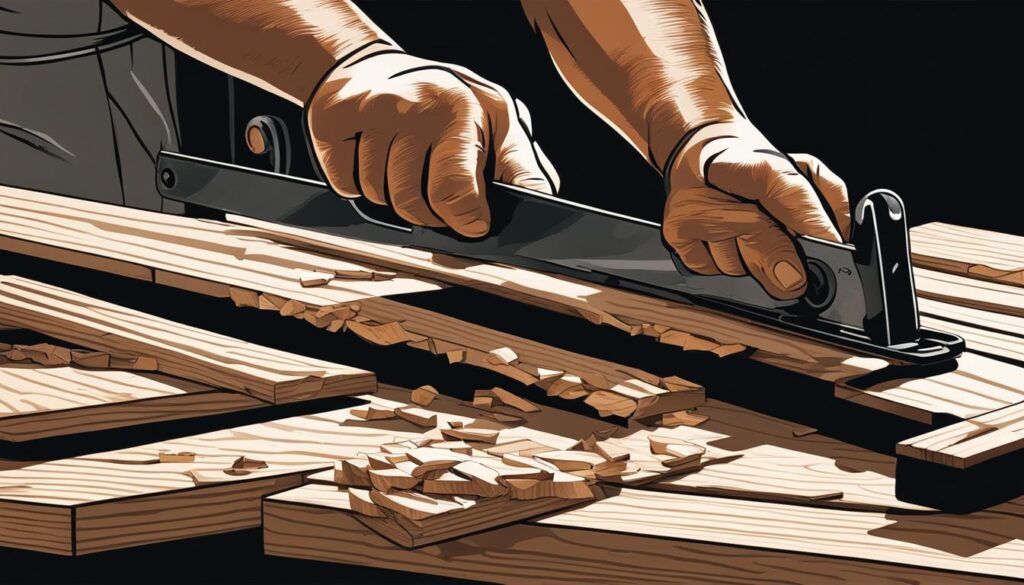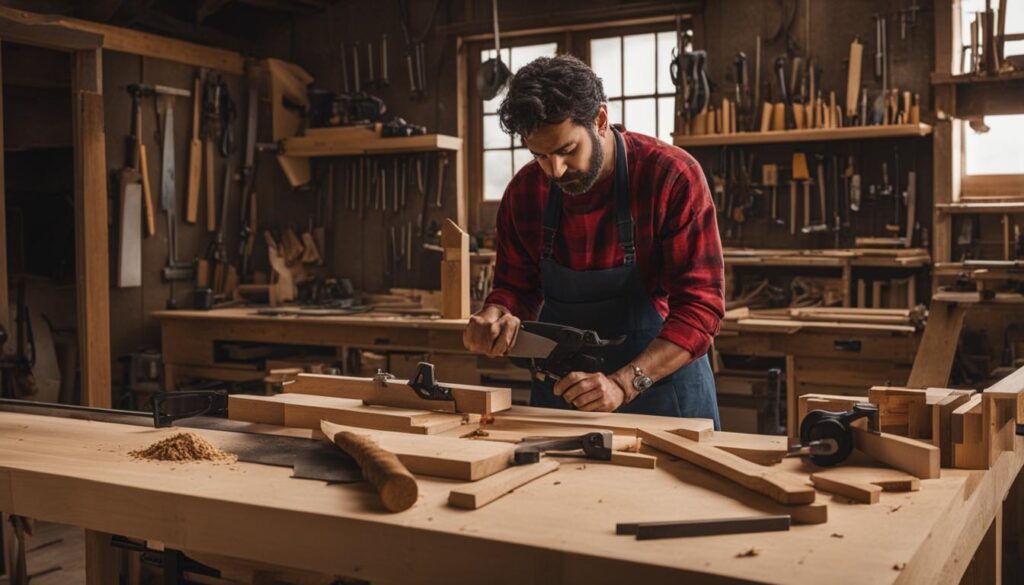We may earn money or products from the companies mentioned in this post.
Woodworking projects often require choosing the right wood for durability, aesthetics, and functionality. With so many different types of wood available, selecting the ideal one can be overwhelming. This comprehensive guide will help you make informed decisions about the different wood types and characteristics.
By understanding the distinct qualities of each wood species, you can determine the best wood for your DIY projects. From the best wood types for furniture, to the types of hardwood and softwood, this guide has got you covered. You will learn how to choose wisely and create stunning woodworking projects.
Key Takeaways
- Understanding wood characteristics is essential when selecting wood for woodworking projects.
- Hardwood and softwood have different properties and are suitable for different woodworking projects.
- Choosing the right wood involves evaluating factors such as moisture content, stability, sustainability, and cost.
- Selecting the wrong wood can result in unsatisfactory project outcomes.
- By evaluating wood types and selection, you can ensure durability, aesthetics, and functionality in your woodworking projects.
Understanding Wood Species and Their Characteristics
Before you decide on the wood species for your woodworking project, it’s essential to understand the characteristics of different woods. Each variety has unique properties that can impact the final product’s durability and appearance.
Some of the common wood characteristics that you should be familiar with include:
- Grain pattern: Wood grains refer to the pattern of the wood fibers. They can be straight, interlocked, wavy, or curly, and each species has a unique grain pattern.
- Hardness: Hardness refers to the wood’s ability to resist dents and scratches. The harder the wood, the more durable it is.
- Color: Wood color varies greatly among species. Some types of wood have a pale, yellowish color, while others have a reddish-brown hue.
- Texture: Wood texture refers to the way the wood feels to the touch. It can range from smooth to rough, depending on the species.
- Durability: Durability indicates the wood’s resistance to decay, insects, and other damage over time.
By understanding the unique characteristics that different wood species bring to the table, you can make an informed decision for your next project.
Types of Hardwood for Furniture Making
When it comes to building beautiful and durable furniture, hardwood is often the preferred choice for its strength and unique characteristics. However, choosing the right hardwood for your project can be a daunting task. Let’s take a closer look at some of the most popular types of hardwood and their suitability for furniture making.
Oak
Oak is a popular choice for furniture due to its durability and attractive grain patterns. Its strength and resilience make it suitable for heavy-use furniture such as dining tables and chairs. Oak is available in red and white varieties, with red oak being slightly harder and more durable.
Maple
Maple is a versatile hardwood that is ideal for creating furniture with clean lines and a contemporary look. Its light color and uniform grain pattern make it a popular choice for modern furniture designs. Maple is also strong and durable, making it suitable for furniture that will see regular use.
Cherry
Cherry wood has a rich, warm color that darkens over time, giving furniture a beautiful patina. It is often used for high-end furniture, such as cabinets and tables, due to its durability and unique grain patterns. Cherry is also easy to work with and finishes well.
Walnut
Walnut is a darker wood that is known for its rich, warm tones and attractive grain patterns. It is often used for luxurious and high-end furniture pieces. Walnut is highly durable and has a natural resistance to decay, making it a great choice for furniture that will be used frequently.
When choosing the right hardwood for your furniture project, consider the style of furniture you want to create, the level of durability required, and the overall aesthetic you want to achieve. With these factors in mind, you can confidently choose the perfect hardwood for your DIY project.
Exploring Types of Softwood for Versatile Projects
Softwood is a popular choice for many DIY projects due to its versatility and affordability. While it may not offer the same hardness as hardwood, it offers unique characteristics that make it a valuable material for woodworking creations. In this section, we will explore common types of softwood and their suitability for various projects.
Pine
Pine is a widely available softwood that is easy to work with, making it a favorite among DIY enthusiasts. Its light color and straight grain make it an excellent choice for furniture and interior construction. Pine is often used for shelving, cabinets, and trim. Its low cost and versatility make it a popular choice for beginners and experienced woodworkers alike.
Spruce
Spruce is a softwood with a pale color and a straight grain pattern. It is commonly used in construction, including framing, as well as for making musical instruments, such as guitars and violins. Spruce is a lightweight wood with a high strength-to-weight ratio, making it a dependable choice for structural applications.
Cedar
Cedar is a softwood with a pleasant aroma and natural resistance to decay and insects. It has a warm color and distinctive grain pattern that makes it an excellent choice for furniture, outdoor structures, and decorative elements. Cedar is often used for making fences, decks, and cedar chests. Its durability and resistance to rot and pests make it a favored choice for outdoor projects.
Choosing the Right Wood
When selecting softwood for your DIY projects, it is essential to consider its characteristics and suitability for your intended use. Factors such as wood density, strength, and moisture content can impact the performance and longevity of your creations. By understanding these factors and choosing the right wood for your project, you can achieve beautiful and functional results.
Factors to Consider When Selecting Wood for Projects
When selecting wood for your woodworking projects, it is important to consider several factors beyond the type of wood species. Each factor can have a significant impact on the performance, durability, and overall satisfaction with your finished project.
Wood Characteristics
The characteristics of the wood play a major role in determining its suitability for different projects. These characteristics may include grain patterns, hardness, texture, stability, and durability. Hardwood species such as Oak, Maple, Cherry, and Walnut are known for their durability and beauty which makes them ideal for furniture making. Softwood species like pine, spruce, and cedar are more affordable and easier to work with which makes them a great choice for DIY projects that require versatility.
Moisture Content
The moisture content of the wood is another crucial factor to consider when selecting wood for your woodworking project. If wood is too moist or too dry, it can warp, split or crack, affecting its durability. You must consider the moisture content of the wood before purchasing it and inspect it for any signs of splitting or warping. Kiln-dried wood is a popular option for woodworking projects as it has been dried to a moisture content of 6-8%, making it more stable and less prone to warping.
Stability
The stability of the wood is another important factor to consider when selecting wood for your project. Stability refers to the wood’s ability to maintain its size and shape under various conditions. Woods that are more stable have been known to resist changes in temperature and humidity, making it less susceptible to warping and splitting. Woods like oak and maple are known for their higher stability and are therefore ideal for furniture making where stability is a requirement.
Sustainability
In light of environmental concerns, sustainability is another factor that should be considered when selecting wood for your project. Some woods are considered more sustainable than others, and selecting these types of woods can help promote responsible use of natural resources. Popular sustainable woods for woodworking projects include bamboo and eucalyptus, which grow faster than traditional hardwoods.
Cost
Finally, cost is another factor to consider when selecting wood for your project. Some types of wood are more expensive than others, making them ideal for more high-end projects. Other types of wood are more affordable, making them ideal for DIY projects or beginner woodworkers.
By considering these factors when selecting wood for your project, you can ensure that you make an informed decision based on your needs, budget, and personal preferences. Remember, choosing the right wood is crucial to the success of your woodworking project.
Conclusion
Choosing the right wood is essential for the success of your woodworking projects. Through this comprehensive guide, you have learned about the different types of wood, their characteristics, and the factors to consider when selecting wood for your projects.
Make Informed Choices
By considering the type of wood species, including hardwood and softwood, and evaluating important factors such as cost, moisture content, stability, and sustainability, you can ensure the durability, functionality, and aesthetics of your woodworking projects. Always take into account these factors when selecting the ideal wood for your furniture and DIY projects.
Happy Woodworking!
We hope this guide has equipped you with valuable knowledge to make informed choices for your woodworking projects. Remember, the right wood choice will make a significant difference in the overall quality of your project. Happy woodworking!
FAQ
What are the different types of wood species?
There are various types of wood species, including hardwood and softwood. Some popular hardwood species include oak, maple, cherry, and walnut, while common softwood species include pine, spruce, and cedar.
What should I consider when selecting wood for my projects?
When selecting wood, it is important to consider factors such as moisture content, stability, sustainability, and cost. These aspects can influence the performance and longevity of your woodworking projects.
Why is hardwood often preferred for furniture making?
Hardwood is often preferred for furniture making due to its durability and beauty. Woods like oak, maple, cherry, and walnut offer excellent strength and aesthetics, making them ideal choices for creating furniture pieces.
Is softwood suitable for woodworking projects?
Yes, softwood can be a great choice for many woodworking projects. It is often more affordable and easier to work with compared to hardwood. Popular softwood options include pine, spruce, and cedar.
How can I choose the right wood for my DIY projects?
To choose the right wood for your DIY projects, you should consider factors such as the project’s requirements, desired aesthetics, and budget. Understanding the characteristics of different wood species and their suitability for specific applications can guide your decision-making process.
Affiliate Disclosure: This post may contain affiliate links. If you purchase through our link, we may receive a small commission, but at no additional cost to you. For more information, please see our Disclosure statement.



